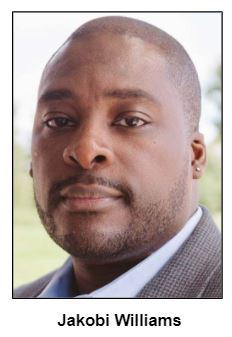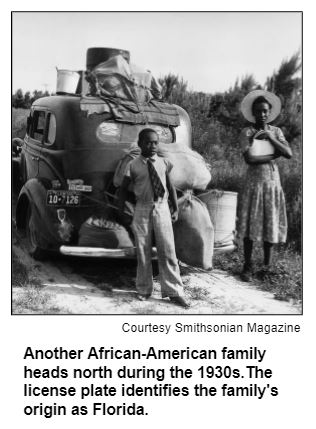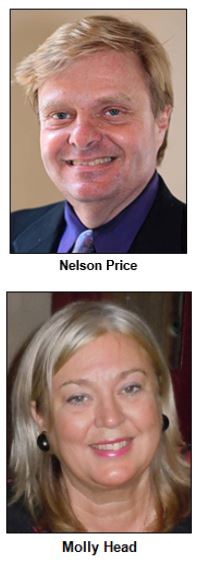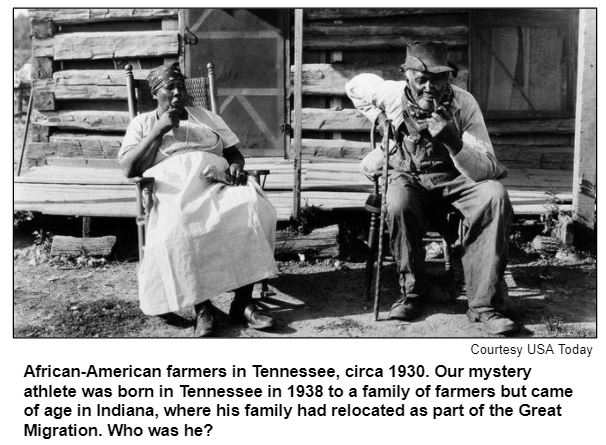Saturdays, noon to 1 p.m. ET on WICR 88.7 FM.
Or stream audio live from anywhere on WICR Online!
February 27, 2021
Migration of African Americans during 20th century to Northern states
As Hoosier History Live salutes Black History Month, our focus will be on a massive movement of an estimated 6 million people during a span of nearly 60 years. Beginning during the World War I era, African Americans migrated in unprecedented numbers from the South to cities in Northern states, including Indiana.

Some historians use the term Great Migration to apply to the entire span. Others refer to the era from the 1910s to 1940 as the First Great Migration, and describe the 1940s to 1970 movement as the Second Great Migration.
To explore a range of factors and ramifications associated with this consequential migration, Nelson will be joined by Jakobi Williams, Ruth N. Halls Professor in the Department of African American and African Diasporas Studies and the Department of History at Indiana University.
Jakobi, who was born and grew up on the south side of Chicago, will discuss ways that state and local governments in the South attempted to restrict African Americans from leaving. He also will describe the challenges that confronted them in Northern cities after they resettled.

Our guest Jakobi Williams, the author of From the Bullet to the Ballot (University of North Carolina Press, 2013) , suggests the PBS series Eyes on the Prize as a resource for those who want to learn more about the Great Migration.
Describing the beginnings of the Great Migration, the Smithsonian article notes: "To fill the assembly lines, companies began recruiting Black Southerners to work in the steel mills, railroads and factories. Resistance in the South to the loss of cheap Black labor meant that recruiters often had to act in secret or face fines and imprisonment."
The article describes attempts by public officials in the South to retain African Americans "by arresting them at railroad platforms on grounds of 'vagrancy' or tearing up their tickets."
According to the USA Today analysis, the three states with the largest population of African Americans at the end of the 1890s were Georgia, Mississippi and Alabama. "By 1970, New York, Illinois and California had the most African Americans."
The reverse trend that began in the 1970s - the move of African Americans to the South - generally has been led by young, college-educated professionals and retirees, according to several sources.
History Mystery
An athlete who made sports history as a teenager in Indiana was not born in the Hoosier state. He was born in 1938 in Tennessee, where his parents came from multi-generational families of farmers.
In his autobiography, he wrote that his parents decided to "join the Great Migration" to the North in search of better work. So the family relocated to Indianapolis when he was a child.
He went on to a sensational sports career at every level: high school, college and the pros. At the 1960 Rome Olympics, he was co-captain of a U.S. team that won a gold medal. He's generally considered to have been one of the best to have ever played his sport.
Question: Who is the athlete who initially came to great fame in Indiana, but was born in Tennessee?
The call-in number is (317) 788-3314. Please do not call in to the show until you hear Nelson pose the question on the air, and please do not try to win if you have won any other prize on WICR during the last two months. You must be willing to give your first name to our engineer, you must answer the question correctly on the air and you must be willing to give your mailing address to our engineer so we can mail the prize pack to you.
This week's prizes are two tickets to Minnestrista gathering place in Muncie, featuring the Bob Ross Experience, courtesy of Minnestrista, and four tickets to Indy's Teeny Statue of Liberty Museum, courtesy of Tim and Julie's Another Fine Mess.
We get by with a little help from our friends

If you are part of an organization or business that would like a promotional boost, please consider providing a prize for the weekly History Mystery feature of our show. The name of your organization or business will be posted on our online media, and you also get a mention during the live show by our host Nelson. Prizes must fit in a standard business envelope, such as tickets, passes or vouchers. Contact our producer Molly Head, molly@hoosierhistorylive.org, for more information.
We always strive to feature exciting new guests and intriguing topics on the show, but we'd love to get some fresh ideas from our listeners. If you have a suggestion for a featured guest or a main topic for a show, please reach out to Molly at the same email address posted above. Include "guest/show topic idea" in the email header. If you do propose a topic, you must include possible guests who could speak authoritatively about it, and their contact information. Include some notes to support your idea, too. Be aware that we do make our own editorial decisions.
As the danger of the pandemic passes and social distancing restrictions ease, we're also hoping to revive Hoosier History Live listening groups, and we are reaching out to volunteer organizers. The idea behind the listening groups is for people to gather on Saturdays a little before noon, listen to the live show and then discuss. It's a great social and educational opportunity for libraries, small businesses, and history and community centers. All you need is an organizer, a listening device such as a radio or a computer or phone hooked up to a speaker, and a quiet place with comfortable chairs. Again, contact Molly Head if you'd like help setting up a listening group.
And finally, we always appreciate your financial support. Our researchers, writers, editors, artists, and marketers are working hard to keep Hoosier History Live part of the intellectual life of our beloved Indiana, and we can't do it without you. You can visit the yellow Donate button on our website or newsletter to use a bank account or PayPal, or write a check to Hoosier History Live and send it to P.O. Box 44393, Indianapolis IN 46244-0393.
Thanks, friends, for helping to support local journalism!
Nelson Price, host and historian
Molly Head, producer/general manager, (317) 927-9101
Mick Armbruster, associate producer
Cheryl Lamb, administrative manager
Richard Sullivan, senior tech consultant
Pam Fraizer, graphic designer
Garry Chilluffo, consultant
Please tell our sponsors that you appreciate their support!

 For organizational sponsorship, which includes logos, links, and voiced credits in the show and in podcasts, email molly@hoosierhistorylive.org, or call (317) 927-9101 for information. Our podcast listens are increasing and we are being distributed on Indiana Memory and the National Digital Public Library. Grow with us as our podcast and internet presence expands! Thanks also to Visit Indy, Fraizer Designs, WICR-FM, Henri Pensis, Genesis Brown, Kielynn Tally, Heather McIntyre, Justin Clark, and many other individuals and organizations.
For organizational sponsorship, which includes logos, links, and voiced credits in the show and in podcasts, email molly@hoosierhistorylive.org, or call (317) 927-9101 for information. Our podcast listens are increasing and we are being distributed on Indiana Memory and the National Digital Public Library. Grow with us as our podcast and internet presence expands! Thanks also to Visit Indy, Fraizer Designs, WICR-FM, Henri Pensis, Genesis Brown, Kielynn Tally, Heather McIntyre, Justin Clark, and many other individuals and organizations.
Thank you!
We'd like to thank the following recent, new and renewal contributors whose donations help make this show possible!
- Kathleen Angelone
- Tim and Meg Shelly
- Connor & Company, Inc.
- Georgia Cravey and Jim Lingenfelter
- Ann Frick
- Yetta Wolen
- In memory of William G. "Bill" Mihay
- Dr. William McNiece
- Michael Freeland and Sharon Butsch Freeland
- David E. and Lynne J. Steele
- Stacia Gorge
- Margaret Smith
- Rachel Perry
- Tom and Linda Castaldi
March 6, 2021 - coming up
Women, the Indiana General Assembly and state officials

What questions have been asked of women candidates for public office that have not been posed to their male counterparts? What's been the percentage of female lawmakers at the Indiana Statehouse? Why has Indiana's lieutenant governor frequently been a woman during the last 20 years, but a woman never has served as governor?
Not only will we delve into those questions, we even will look at the number of women honored with statues and marble busts at the Indiana Capitol Building, compared with those that commemorate men.
The latter issue was the focus of a column a few years ago by the acclaimed, retired political journalist who will be Nelson's guest in this show on women's history in Indiana. Beginning in 1991, Mary Beth Schneider covered every session of the General Assembly for the Indianapolis Star until 2013. She also covered national political conventions, presidential debates and the caucuses and primaries in Iowa, New Hampshire and other states.
During her career at the Star, which began in 1979, Mary Beth covered a variety of other beats and served as an assistant city editor; in 2019 and 2020, she wrote a weekly political column and edited stories for TheStatehouseFile.com, a news service run by Franklin College students.
According to state legislative records, women lawmakers make up about 21 percent of the current General Assembly. Of the nine members of the U.S. Congress from Indiana, two are women. Since 2003, when Gov. Joe Kernan appointed Kathy Davis, a Democrat from Indianapolis, as the first women lieutenant governor in Indiana's history (her successor, Becky Skillman, a Republican from Bedford, became the first woman elected to the position, serving two terms under Gov. Mitch Daniels), the state's No. 2 post has been held by a woman except for about nine months in 2016. That's when current governor Eric Holcomb had the job.
Some history facts:
- In 1920, the year that women achieved the right to vote with the ratification of the 19th Amendment, the first woman was elected to the Indiana legislature. She was Julia Nelson, a Republican from Muncie.
- The first woman elected to the U.S. Congress from Indiana was Virginia Jenckes, a Democrat from Terre Haute. Hoosier History Live discussed Jenckes, who was elected in 1932, during a show last March that focused on Hoosier women who advocated for suffrage.
- In a 2019 column for TheStatehouseFile.com, our guest Mary Beth Schneider noted that the second floor of the Indiana Capitol Building has seven busts, all of them men. All of the eight busts on the third floor also honor men except for one, a bust commemorating the late U.S. Rep. Julia Carson.
Copyright 2021









